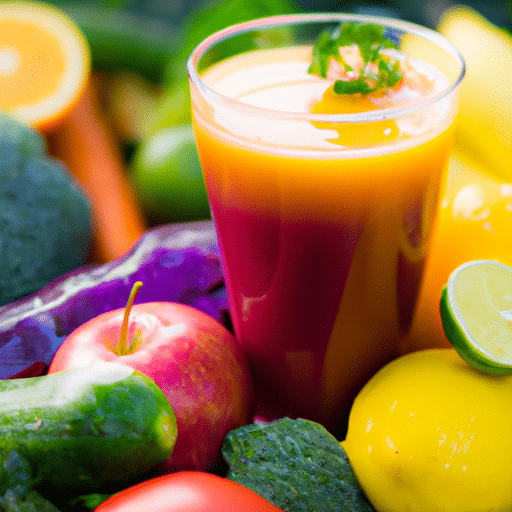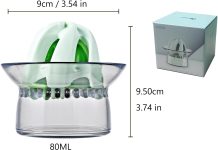If you’ve found yourself wondering how often you should be juicing, you’re not alone. With the growing popularity of juicing and its potential health benefits, it’s natural to want to incorporate this healthy habit into your routine. But how many times a week is the right amount? In this article, we’ll explore the factors that can influence the frequency of juicing and provide some guidance to help you determine the ideal number of juicing sessions per week. So, if you’re ready to juice your way to better health, keep reading!
Review contents
Health benefits of juicing
Increased nutrient intake
Juicing is a great way to increase our nutrient intake and ensure that we are getting a wide variety of vitamins, minerals, and antioxidants from fruits and vegetables. By juicing, we can easily consume a larger quantity of produce than we would typically eat in one sitting. This allows us to benefit from the abundance of nutrients found in fruits and vegetables, which are essential for our overall health and well-being.
Promotes hydration
Juicing is an excellent way to stay hydrated as it provides us with a refreshing and delicious source of liquid. Fruits and vegetables naturally contain water, and by juicing them, we can easily increase our fluid intake. Proper hydration is crucial for many bodily functions, including digestion, circulation, and maintaining healthy skin. Incorporating freshly made juices into our daily routine can help us meet our hydration needs and keep us feeling energized throughout the day.
Boosts immune system
One of the significant advantages of juicing is its ability to boost our immune system. Fruits and vegetables are packed with vitamins and minerals that help strengthen our immune response and protect us against illnesses. The high concentration of antioxidants found in fresh juices helps to neutralize harmful free radicals and reduce inflammation in our bodies. By regularly consuming nutrient-rich juices, we can give our immune system the support it needs to function optimally and keep us healthy.
Detoxifies the body
Juicing is often associated with detoxification, and for a good reason. When we juice, we provide our bodies with a concentrated source of nutrients that can aid in the natural detoxification processes. Fruits and vegetables contain fiber and enzymes that help to cleanse our organs, including the liver and kidneys, by flushing out toxins. Incorporating detoxifying juices into our routine can support our body’s natural detoxification pathways and contribute to our overall health.
Factors to consider
Purpose of juicing
Before determining how frequently we should juice, it’s essential to consider our purpose for juicing. Are we looking to boost our overall health, increase our nutrient intake, or detoxify our bodies? Understanding our goals will help us decide on the appropriate frequency of juicing.
Individual health conditions
It’s crucial to take into account any existing health conditions we may have before embarking on a juicing routine. Some health conditions may require specific dietary considerations or restrictions. Consulting with a healthcare professional or registered dietitian can help us determine whether juicing is suitable for our individual health needs and how frequently we should incorporate it into our diet.
Ability to tolerate juices
While juices can be a healthy addition to our diet, some individuals may have difficulty tolerating them. The concentration of sugars in juices can cause digestive discomfort, particularly for those with sensitive stomachs or individuals with certain medical conditions, such as diabetes or gastrointestinal disorders. It’s important to listen to our bodies and adjust our juicing frequency accordingly to avoid any adverse effects.
Nutrient requirements
Different individuals have varying nutrient requirements based on factors such as age, sex, weight, and activity level. It’s essential to consider our unique nutritional needs when deciding how frequently to juice. Including a variety of fruits and vegetables in our juices can help ensure that we are meeting our nutrient requirements while also enjoying the benefits of juicing.
Availability of fresh produce
Fresh produce is the key to making delicious and nutritious juices. It’s important to assess the availability of fresh fruits and vegetables in our area before committing to a juicing routine. If fresh produce is readily accessible, we can consider juicing more frequently. However, if obtaining quality ingredients proves to be challenging, we may need to adjust our juicing frequency accordingly.
Daily juicing
Benefits of daily juicing
For avid juicers who are looking to maximize their nutrient intake, juicing daily can be an effective approach. Daily juicing ensures that we are consistently supplying our bodies with a rich source of vitamins, minerals, and antioxidants. This can have a profound impact on our overall health, energy levels, and even our skin complexion.
Suitable for avid juicers
Daily juicing is suitable for individuals who enjoy the taste of fresh juices and have a passion for incorporating a wide variety of fruits and vegetables into their diet. These individuals often prioritize their health and well-being and are committed to making juicing a daily habit.
Requires access to fresh produce
Since daily juicing requires a significant amount of fruits and vegetables, it’s essential to have reliable access to fresh produce. Living in areas with farmers’ markets, supermarkets, or having access to a community-supported agriculture (CSA) program can ensure a steady supply of fresh ingredients for our daily juices.
Considerations for balanced nutrition
While daily juicing can provide an abundance of nutrients, it’s important to ensure that we are also getting a well-rounded diet that includes other food groups. Juices should supplement our meals rather than replace them entirely. Including sources of protein, healthy fats, and whole grains in our diet is crucial for a balanced and nourishing approach to nutrition.
Potential drawbacks of excessive juicing
While juicing can be incredibly beneficial, excessive juicing can have its downsides. Juices tend to be high in natural sugars, which can lead to blood sugar spikes and ultimately affect our energy levels and overall health. Additionally, excessive juicing may result in a lack of dietary fiber, which is essential for digestive health. It’s important to find a balance and listen to our bodies to avoid any potential drawbacks of excessive juicing.
3-4 times a week
Moderate frequency of juicing
Opting to juice 3-4 times a week provides a moderate frequency that allows us to enjoy the benefits of juicing without relying solely on juices for our nutrient intake. This approach strikes a balance between incorporating fresh juices into our diet while still enjoying solid meals.
Sufficient for most individuals
For many individuals, juicing 3-4 times a week is more than sufficient to reap the health benefits of juicing. These individuals can enjoy the variety and flavors of juices while also maintaining a well-rounded diet that includes other food groups.
Allows for variation in diet
Juicing a few times a week allows us to enjoy the benefits of juicing while also providing us with the freedom to vary our diet. It ensures that we don’t become overly reliant on juices for our nutrient intake and gives us the opportunity to include other whole foods in our meals.
Balances nutrient intake
By juicing 3-4 times a week, we can strike a balance between maximizing our nutrient intake and enjoying the benefits of other food groups. This approach allows us to acquire a diverse range of nutrients while also incorporating other sources of protein, healthy fats, and carbohydrates into our diet.
Less reliance on juices
Opting to juice 3-4 times a week reduces our dependence on juices as the sole source of nutrients. This can be beneficial for individuals who prefer a more varied diet or have specific dietary requirements that may not be met through juicing alone.
1-2 times a week
Infrequent juicing approach
For individuals who prefer a less frequent juicing routine, juicing 1-2 times a week can still offer health benefits. This approach allows for occasional detoxification while maintaining a solid food-based diet for the majority of the week.
Suitable for occasional detox
Juicing 1-2 times a week can serve as an occasional detox to rejuvenate our bodies and support our natural cleansing processes. This approach provides a break from heavier meals and allows us to reset and recharge.
Less reliance on juiced nutrients
With a more infrequent juicing approach, we rely less on the nutrients derived from juices. This may be preferable for individuals who prefer to obtain their nutrients primarily from whole foods or have dietary restrictions that make frequent juicing less practical.
Appropriate for individuals with specific health conditions
Juicing 1-2 times a week may be more appropriate for individuals with specific health conditions that require careful dietary management. These individuals can still benefit from the nutritional boost that juicing provides without compromising their dietary needs.
Lowers overall sugar intake
By reducing the frequency of juicing, we naturally lower our overall sugar intake. This can be beneficial for individuals who are watching their sugar consumption or those with conditions such as diabetes or insulin resistance. It allows for a more controlled and balanced approach to nutrition.
Alternating days
Regular but not daily juicing
Alternating days of juicing provides a regular but not daily approach to incorporating fresh juices into our routine. It allows us to enjoy the health benefits of juicing while maintaining flexibility in our meal planning.
Sustains nutrient intake
By alternating days of juicing, we can sustain our nutrient intake and ensure that our bodies are consistently receiving a variety of vitamins, minerals, and antioxidants from fruits and vegetables. This approach strikes a balance between juicing and solid food consumption.
Offers flexibility in meal planning
Alternating days of juicing offers flexibility when it comes to meal planning. We can enjoy the benefits of juices on certain days while incorporating other whole foods into our meals on alternate days. This approach allows us to adapt our diet to our preferences and lifestyle.
Allows for rest days
Juicing can require some effort and preparation, especially if we are making our juices from scratch. Alternating days of juicing ensures that we have rest days in between, allowing us to take a break from the juicing process and focus on other aspects of our health and well-being.
Fits well into busy schedules
For individuals with busy schedules or those who prefer a simpler approach to juicing, alternating juicing days can be an ideal fit. It provides a regular routine without the need for daily juicing, making it more manageable and sustainable.
Every other week
Minimal juicing frequency
For individuals who prefer a less frequent juicing routine, juicing every other week can be a suitable approach. This minimal frequency allows for occasional detoxification without the need for regular juicing.
Maintains occasional detox
Juicing every other week ensures that we can still incorporate occasional detoxification into our routine. This approach provides us with the opportunity to reset and cleanse our bodies while reducing our reliance on juiced nutrients.
Less reliance on juiced nutrients
By juicing every other week, we reduce our reliance on juiced nutrients and focus more on obtaining nutrients from whole foods. This can be a preferred approach for individuals who enjoy solid meals and find them more satisfying and sustainable in the long term.
Balances juice intake with whole foods
Juicing every other week allows for a balance between enjoying the benefits of juices and incorporating a wide variety of whole foods into our diet. This approach ensures that we are not solely relying on juices for our nutrient intake and allows for a more diverse and satisfying eating experience.
Ideal for individuals who prefer solid meals
For individuals who prefer solid meals over liquids, juicing every other week provides an ideal balance. It allows for occasional juicing while primarily focusing on whole foods, providing a sense of satisfaction and satiety.
Monthly juicing
Infrequent but intentional juicing
Monthly juicing offers an infrequent but intentional approach to incorporating juices into our routine. This allows us to reap the benefits of occasional juicing while taking into account our individual preferences and lifestyle.
Provides occasional nutrient boost
By juicing on a monthly basis, we can provide our bodies with an occasional nutrient boost. This can be especially beneficial for individuals who already have a well-rounded diet but are looking for an extra dose of vitamins, minerals, and antioxidants.
Flexible juicing schedule
Monthly juicing provides a flexible schedule that can be tailored to our needs and preferences. We can choose the specific days of the month that work best for us and incorporate juicing into our routine accordingly.
Allows time for sourcing quality ingredients
With monthly juicing, we have ample time to source quality ingredients and ensure that we are using the freshest produce available. This allows us to prioritize the quality of our juices and make the most out of our juicing experience.
Can be incorporated with lifestyle changes
Monthly juicing can be easily incorporated with lifestyle changes or specific goals we may have. Whether we are looking to kickstart a healthy routine or support other dietary modifications, monthly juicing provides a manageable and intentional approach to incorporating juices into our lifestyle.
Listening to your body
Recognizing signs of over juicing
When it comes to juicing, it’s essential to listen to our bodies and recognize any signs of over juicing. These signs may include digestive discomfort, an upset stomach, fluctuations in energy levels, or even nutrient imbalances. If we experience any of these symptoms, it’s important to adjust our juicing frequency accordingly.
Adjusting juicing frequency accordingly
Our bodies are unique, and what works for one person may not work for another. Adjusting our juicing frequency based on how our bodies respond is crucial. If we feel overwhelmed or notice any negative effects from our current juicing routine, it may be a sign that we need to reduce or modify our juicing frequency.
Monitoring energy levels and digestion
Energy levels and digestion can be valuable indicators of how our bodies are responding to our juicing routine. By monitoring these aspects, we can better understand whether our current juicing frequency is benefiting us or if adjustments need to be made.
Seeking professional advice when needed
If we are unsure about the appropriate juicing frequency for our individual needs, it’s wise to seek professional advice. Consulting with a healthcare professional or registered dietitian can provide us with personalized guidance based on our specific health conditions, nutrient requirements, and overall goals.
Personalizing your juicing routine
Experimenting with different frequencies
Finding the right juicing routine is highly individualized. It’s essential to experiment with different frequencies and assess how our bodies respond. By trying out various juicing routines, we can determine what works best for us in terms of taste, satisfaction, and overall well-being.
Considering individual preferences
When personalizing our juicing routine, it’s important to take into account our individual preferences. Some individuals may enjoy the convenience and simplicity of daily juicing, while others may prefer the occasional detox provided by monthly juicing. By aligning our juicing routine with our preferences, we are more likely to maintain a sustainable and enjoyable habit.
Adapting juicing to changing needs
Our needs and circumstances can change over time. It’s crucial to adapt our juicing routine accordingly. As our lifestyle, health, and preferences shift, so too should our approach to juicing. Being open to adapting and modifying our routine ensures that our juicing habit remains relevant and enjoyable.
Maintaining a well-rounded diet
Regardless of our juicing frequency, it’s important to maintain a well-rounded diet that includes a variety of food groups. Juices should complement our meals and act as a supplementary source of nutrients rather than a substitute for whole foods. Incorporating a diverse range of fruits, vegetables, proteins, healthy fats, and whole grains ensures that we are meeting our nutritional needs comprehensively.
Finding a sustainable juicing routine
Above all, it’s essential to find a juicing routine that is sustainable in the long term. Whether it’s juicing daily, a few times a week, or on a monthly basis, our routine should align with our lifestyle and be enjoyable. By finding a balance that works for us, we can reap the health benefits of juicing while maintaining a sustainable and satisfying approach to nutrition.


































